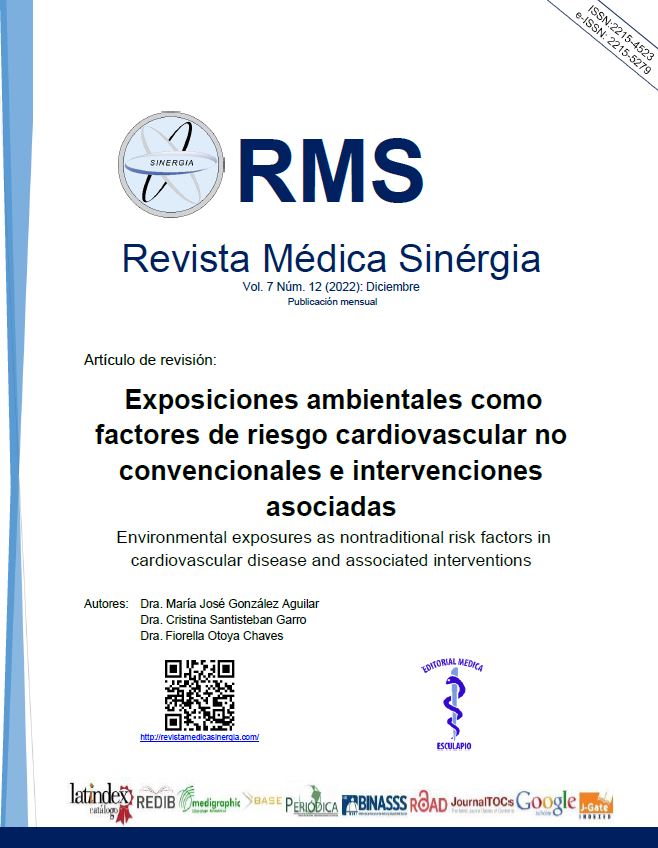Resumen
La contaminación ambiental representa un factor de riesgo cardiovascular no tradicional capaz de provocar alteraciones hemodinámicas y moleculares importantes con consecuencias clínicas y vitales significativas. De tal manera, se ha posicionado en consenso por distintas sociedades cardiológicas internacionales dentro de los primeros cinco factores de riesgo de mortalidad cardiovascular, solo por detrás de la hipertensión, el tabaquismo y la mala alimentación.
La contaminación del aire con partículas finas <2,5 μm (PM2.5) es el factor de riesgo ambiental más importante que contribuye a dicha morbimortalidad, representando una gran amenaza para la salud pública mundial. Sin embargo, la contaminación sonora también se ha asociado con la aparición de eventos cardiovasculares mayores a través de múltiples vías fisiopatológicas, siendo el sexo masculino más susceptible a los efectos cardiovasculares de la exposición crónica al ruido.
Palabras clave
Citas
Zipes D, Libby P, Bonow R, Braunwald E. Braunwald Tratado de Cardiología: Texto de Medicina Cardiovascular. 11ma ed. Elsevier. Madrid; 2019.
Lerman J. Factores de riesgo cardiovascular no convencionales. Revista de la Asociación Médica Argentina [Internet]. 2020;133(1). Disponible a partir de: https://www.google.com/url?sa=t&rct=j&q=&esrc=s&source=web&cd=&ved=2ahUKEwj57PTn1q74AhVRkIQIHd1xBrAQFnoECAsQAw&url=https%3A%2F%2Fwww.ama-med.org.ar%2Fdescargacontenido%2F356&usg=AOvVaw0zi9M04YSw_CRlOlx3oAHB
GBD 2019 Risk Factors Collaborators. Global burden of 87 risk factors in 204 countries and territories, 1990–2019: A systematic analysis for the Global Burden of Disease Study Lancet; [Internet] 2020. 396(10258):1223–1249. Doi: http://dx.doi.org/10.1016/S0140-6736(20)30752-2
Landrigan PJ, Fuller R, Acosta NJR, et al. The Lancet Commission on pollution and health. Lancet [Internet] 2018; 391:462–512. Doi: http://dx.doi.org/10.1016/S0140-6736(17)32345-0
Brauer M, Casadei B, Harrington RA, Kovacs R, Sliwa K, Expert Group the WAP. Taking a Stand Against Air Pollution – The Impact on Cardiovascular Disease: A Joint Opinion from the World Heart Federation, American College of Cardiology, American Heart Association, and the European Society of Cardiology. Global Heart; [Internet] 2021;16(1):8; Doi: http://dx.doi.org/10.5334/gh.948
Rajagopalan S, Al-Kindi SG and Brook RD. Air Pollution and Cardiovascular Disease. JACC State-of-the-Art Review J Am Coll Cardiol [Internet] 2018; 72:2054-70 Doi: http://dx.doi.org/10.1016/j.jacc.2018.07.099.
Münzel T, Gori T, Al-Kindi S, et al. Effects of gaseous and solid constituents of air pollution on endothelial function. Eur. Heart J. [Internet]. 2018;39(38):3543–50. Doi: http://dx.doi.org/10.1093/eurheartj/ehy481
Schraufnagel DE, Balmes JR, Cowl CT, et al. Air Pollution and Noncommunicable Diseases: A Review by the Forum of International Respiratory Societies’ Environmental Committee, Part 2: Air Pollution and Organ Systems. Chest. [Internet]. 2019;155(2):417–26. Doi: http://dx.doi.org/10.1016/j.chest.2018.10.042
Chen R, Jiang Y, Hu J, Chen H, Li H, Meng X, Ji JS, Gao Y, Wang W, Liu C, et al. Hourly air pollutants and acute coronary syndrome onset in 1.29 million patients. Circulation [Internet] 2022;145:1749–1760. Doi: http://dx.doi.org/10.1161/CIRCULATIONAHA.121.057179
WHO global air quality guidelines: Particulate matter (PM2.5 and PM10), ozone, nitrogen dioxide, sulfur dioxide and carbon monoxide. Geneva: World Health Organization [Internet] 2021. 3, Recommendations on classical air pollutants. Disponible a partir de: https://www.ncbi.nlm.nih.gov/books/NBK574591/
Bennett JE, Tamura-Wicks H, Parks RM, et al. Particulate matter air pollution and national and county life expectancy loss in the USA: A spatiotemporal analysis. PLOS Med. [Internet]. 2019;16(7): e1002856; Doi: http://dx.doi.org/10.1371/journal.pmed.1002856
Apte J, Brauer M, Cohen A, Ezzati M, Pope C. Ambient PM 2.5 Reduces Global and Regional Life Expectancy. Environmental Science & Technology Letters. [Internet]. 2018. Doi: http://dx.doi.org/10.1021/acs.estlett.8b00360.
Yin P, Guo J, Wang L, Fan W, Lu F, Guo M, et al. Higher Risk of Cardiovascular Disease Associated with Smaller Size-Fractioned Particulate Matter. Environmental Science & Technology Letters. [Internet]. 2020;7(2):95-101. Doi: https://doi.org/10.1021/acs.estlett.9b00735
Munzel T, Sørensen M, Schmidt M, et al. The Adverse Effects of Environmental Noise Exposure on Oxidative Stress and Cardiovascular Risk. Antioxidants and Redox Signalinng [Internet]. 2018; 28: 873-908. Doi: http://dx.doi.org/0.1089/ars.2017.7118
Koczorowski M, Bernard N, Mauny F, et al. Environmental noise exposure is associated with atherothrombotic risk. Sci Rep 12, 3151 [Internet]. 2022. Doi: http://dx.doi.org/10.1038/s41598-022-06825-0
Osborne MT, Radfar A, Hassan MZO, et al. A neurobiological mechanism linking transportation noise to cardiovascular disease in humans. Eur Heart J. [Internet]. 2019. Doi: http://dx.doi.org/10.1093/eurheartj/ehz820.

Esta obra está bajo una licencia internacional Creative Commons Atribución-NoComercial 4.0.
Derechos de autor 2022 Array


